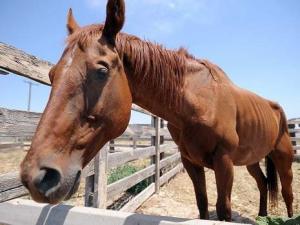 A malnourished horse has been denied adequate food and water for a
very long time. They suffer both physically and psychologically from this and evidence will be in both
appearance and personality.
A malnourished horse has been denied adequate food and water for a
very long time. They suffer both physically and psychologically from this and evidence will be in both
appearance and personality.
1. Look at the hooves. Hooves of a malnourished horse are often cracking or
broken with soft hoof walls. They may even crumble when the horse walks on a hard surface such as concrete and
may be very painful.
2. Take a look at the coat. Malnourishment affects the coat very quickly and a
horse suffering from it may have missing hair, flaky skin and sores.
3. Look around the area where the horse is kept. Signs of a potentially
malnourished animal include sparse pasture, no or little water supply and a noticeable absence of grains or
hay.
4. Protruding bones are a clear sign of a malnourished horse. You should not
be able to see shoulder, rib or hip bones in a well treated horse. Horses that are severely malnourished may
appear as though their skin has been stretched taut over the skeleton.
5. Look at the mane and then run your hands through it. Malnourished horses
may have manes that are discolored from too much sun and not enough nutrient. And though the hair may grow
long, mane and tail hair will be brittle and break easily.
6. Have a vet check for parasites as they often take advantage of an under
nourished animal. They may be contributing and in some cases can even be a cause of malnourishment.
7. Have a good listen to the chest and see if you notice any labored or odd
sounding breathing. Malnourished horses often develop respiratory problems more easily than healthy
horses.
8. Encourage the horse to move. Get him to walk, trot or canter if he can so
you can evaluate the level of malnourishment. When any animal isn't receiving enough nutrition, the body begins
to devour itself. Watch him move, he may be lame or just stiff but a malnourished horse will definitely be
uncomfortable.
9. Spend some one on one time with the horse and evaluate its mental state.
Malnourishment can lead to a withdrawn personality that is easily frightened and startled.
10. Be careful around a horse you feel may be malnourished. Because it affects
them psychologically, they may become aggressive towards humans or hyper sensitive to touch. You don't them to
become agitated and hurt you or themselves.
Related Articles
Breaking a Leg- What It Means For Your
Horse
Deadly Equine Diseases
Tips for Keeping Flies Under
Control
Horse Inspection Checklist
Five Most Common Horse Diseases
How to Spot a Malnourished Horse
Top 10 Most Poisonous Plants for Horses
Feeding and Rebuilding a Malnourished
Horse
Helping a Horse Living with Cushing's
How to Treat Abscesses on Your Horse
Colic and Your Horse
Confirming That Your Horse Has Rabies
Helping a Pregnant Mare
Handling a Rattlesnake Bite to Your
Horse
Being Aware of Tetanus and Your Horse
Preventing Thrush in Your Horse